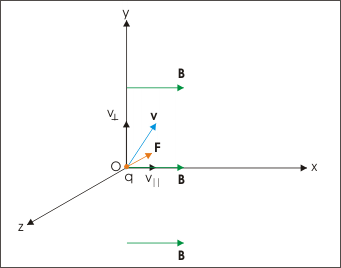| << Chapter < Page | Chapter >> Page > |
By geometry, the angle between pair of lines is same as the angle between the lines perpendicular to them. Hence,
and
The length of arc, AEC is :
Substituting for R, we have :
The time of travel in the magnetic field is :
When charged particle enters magnetic field at right angle, velocity vector is perpendicular to the boundary of magnetic field. We know that a tangent can be drawn on a circle in this direction only at the points obtained by the intersection of the circle by the boundary line which divides the circle in two equal sections. A charged particle can, therefore, travel a semicircular path when it enters into the region magnetic field at right angle, provided of course the span of magnetic is sufficient.
Motion of charged particle entering a magnetic field at right angle

We should understand that circular arc path as obtained by the analysis above can be subject to availability of magnetic field till the charged particle begins to move backwards. For a smaller extent of the magnetic field, we find that the particle emerges out of the magnetic field without being further deviated. If the extent of magnetic field is greater than or equal to R, then charged particle describes up to a semicircle depending on the angle at which it enters magnetic region. However, if the extent of magnetic field is less than R, then particle emerges out of the magnetic field without being further deviated.
This is the general case of motion of a charged particle in magnetic field. Here, velocity and magnetic field vectors are at an acute angle θ. In order to study the motion, we resolve the velocity vector such that one of the components is parallel and other is perpendicular to the magnetic field.
The velocity component perpendicular to the magnetic field results in a magnetic force which provides the necessary centripetal force for the particle to move along a circular path as discussed in previous section. On the other hand, the velocity component parallel to magnetic field results in zero magnetic force and motion in this direction is unaffected due to this component of velocity. The charged particle moves in this direction without being accelerated.
We can visualize superimposition of two motions. The initial conditions of set up are shown in the figure in which particle is shown to have velocity v at the origin of coordinate system. The magnetic field is directed in x-direction. The magnetic force (F) due to perpendicular component of velocity and magnetic field is directed in negative z-direction.
Helical motion

If we ignore the parallel component of velocity, then particle will follow circular path due to perpendicular component of velocity in y-z plane as shown here :
Helical motion


Notification Switch
Would you like to follow the 'Electricity and magnetism' conversation and receive update notifications?